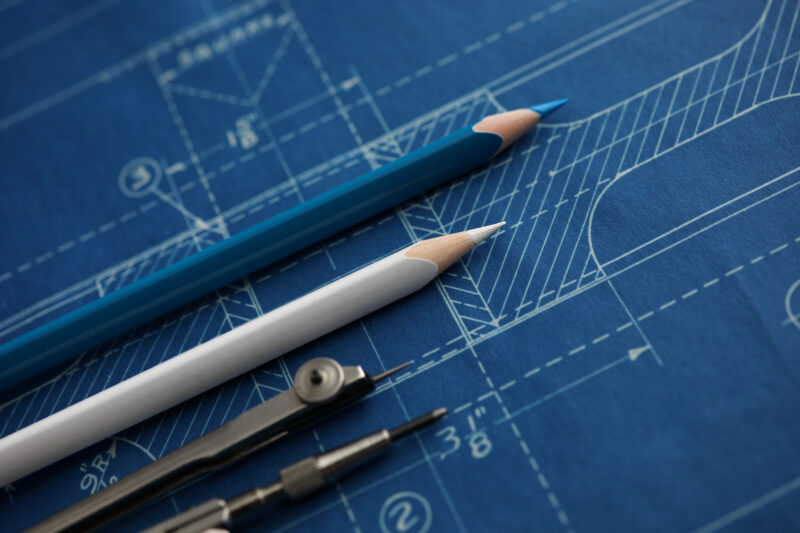The concept of a piece of art that is architectural in nature or an artistically designed building being copyrightable might seem fairly self-explanatory, but what about the design plans for that architectural creation? Do the drawings created by an architect designing how a building will look ever attract its own separate copyright protection? Can those designs be used by someone else trying to create a similar looking building? Continue reading for a look at the ways in which architectural designs and plans are protected under the Canadian Copyright Act and Canadian caselaw.
Are architectural designs copyrightable works?
An architectural design falls under the category of “artistic works,” which includes drawings, maps, charts, plans, photographs, and architectural works.[1] An “architectural work” is defined as “any building or structure or any model of a building or structure.”[2] The significance of these definitions is that a building can be protected by copyright, as well as the various drawings, sketches, designs, and models related to said building.
The architect, as the person who creates the original fixed expression in the form of drawings, is the first owner of the copyright in the architectural design.[3] There is an exception if the work is created in the course of the architect’s employment, in which case the employer will be the first owner of the copyright,[4] although the architect will still retain certain moral rights to the integrity of the work and the right to be associated with it, unless those rights have been waived.[5] In such a situation, in order to use the architectural designs, both the employer’s ownership rights and the architect’s moral rights would have to be addressed (such as through a licensing agreement for use of the work) in order for anyone else to recreate the architectural design.
What does an architectural design need to be protected by copyright?
Not all architectural works or designs are protected by copyright.
An architectural design is protected by copyright if it is “achieved through the exercise of the designer’s skill and judgment, not through a simple mechanical application of their knowledge and experience.”[6] Amendments in 1988 removed the requirement that architectural works need to possess an artistic quality or character,[7] so “if the work originates from its author in that it was not copied and is the product of the author’s skill and judgment, there is no need to venture further and demonstrate the novel, unusual, or distinctive aspect of the work.”[8]
The burden of proving that copyright does not exist in an architectural work is on the defendant because there is a presumption in favour of the existence of copyright.[9]
The following are two examples of cases where the courts came to different decisions on whether a specific architectural design was protected:
- Lainco Inc v Commission scolaire des Bois-Francs: In this case, the architectural design of a soccer stadium was protected by copyright and that copyright was infringed when a company built a structure that amounted to an unauthorized reproduction of a substantial part of the original architectural design. This case represents one of the first times in recent years where a building structure was found to benefit from copyright protection as an architectural work under the Copyright Act.
- Betaplex Inc v B&A Construction Ltée:[10] In this case, the architectural design of a model home did not attract copyright protection because it “did not require any particular skill, that is to say any knowledge, developed aptitude, or practised ability […] and had not in any way solicited, […] ‘one’s capacity for discernment or ability to form an opinion or evaluation by comparing different possible options in producing the work.’”[11]
What would constitute infringement of an architectural design?
Infringement can happen even if there has not been an exact imitation of a work so long as it reproduces a substantial or important part of the work.[12] In the Lainco Inc case, photographs were taken of the original design and the infringers visited the stadium, which the court determined gave the infringers enough access to the design to allow for reproduction, but it is important to note that the court made it clear that infringement can happen even if a work is recreated from memory.[13]
A court would not consider the work/effort that went into the creation of a building or design plan based on the copyrighted work because “simply having to exercise some skill and judgment to produce the infringing work is not relevant.”[14] A court would also not consider the fact that a building would be a recreation in a different form than the original design on paper. “[T]he infringing work can be in a material form other than that of the infringed work. Thus, plans can be infringed indirectly by reproducing a three-dimensional object created from them, and vice versa.”[15]
Important Takeaway: Who can be held liable for infringing the copyright of an architectural work?
It is important to note that in the Lainco Inc case, a school board, an engineering firm, an architectural firm, and a general contractor were all held liable for the recreation of the soccer stadium’s design, which illustrates that entities may not have to be directly involved in the infringement to be held liable for it. The best solution for avoiding infringement of architectural designs is to receive authorization from the design’s copyright owner before using it as a basis for creating any other type of work.
[1] Copyright Act, RSC, 1985, c C-42 at s 2 [Copyright Act].
[2] Ibid.
[3] Hay v Sloan, [1957] OWN 445, at p 403.
[4] Copyright Act, supranote 1 at s 13(3).
[5] Ibid at s 17.1.
[6] Lainco Inc v Commission scolaire des Bois-Francs, 2017 FC 825 at para 96 [Lainco Inc].
[7] Ibid at para 48.
[8] Ibid at para 104.
[9] Copyright Act, supranote 1 at s 34.1(1)(a).
[10] Betaplex Inc v B&A Construction Ltée, 2006 QCCA 886.
[11] Lainco Inc, supra note 6 at para 104.
[12] France Animation, sa c Robinson, 2011 QCCA 1361 at para 57.
[13] Lainco Inc, supra note 6 at para 167.
[14] Ibid at para 205.
[15] Ibid at para 215.
Concepts architecturaux : peuvent-ils être protégés par le droit d’auteur?
La notion d’œuvre d’art de nature architecturale ou d’un bâtiment conçu artistiquement pouvant être protégée par le droit d’auteur peut sembler assez évidente, mais qu’en est-il des plans de conception de cette création architecturale? Les dessins créés par un architecte chargé de concevoir l’apparence d’un bâtiment ne pourront-ils jamais bénéficier de leur propre protection par le droit d’auteur? Ces concepts peuvent-ils être utilisés par une autre personne qui essaie de créer un bâtiment similaire? Poursuivez votre lecture pour en apprendre davantage sur la protection des concepts et des plans architecturaux en vertu de la Loi sur le droit d’auteur (Canada) et de la jurisprudence canadienne.
Les concepts architecturaux sont-ils des œuvres protégées par le droit d’auteur?
Un concept architectural entre dans la catégorie des « œuvres artistiques », qui comprend les dessins, les cartes, les graphiques, les plans, les photographies et les œuvres architecturales[1]. Une « œuvre architecturale » est définie comme « tout bâtiment ou édifice ou tout modèle ou maquette de bâtiment ou d’édifice »[2]. L’importance de ces définitions réside dans le fait qu’un bâtiment peut être protégé par le droit d’auteur, ainsi que les différents dessins, croquis et modèles liés audit bâtiment.
L’architecte, en tant que personne qui crée l’expression fixe originale sous la forme de dessins, est le premier titulaire du droit d’auteur sur le concept architectural[3]. Il existe une exception si l’œuvre est créée dans l’exercice de l’emploi de l’architecte, auquel cas l’employeur sera le premier titulaire du droit d’auteur[4], bien que l’architecte conservera toujours certains droits moraux sur l’intégrité de l’œuvre et le droit d’y être associé, à moins que ces droits aient fait l’objet d’une renonciation[5]. Dans une telle situation, afin d’utiliser les concepts architecturaux, il faudrait tenir compte à la fois des droits de titularité de l’employeur et des droits moraux de l’architecte (par exemple, au moyen d’un contrat de licence pour l’utilisation de l’œuvre) dans le but que quiconque puisse recréer les concepts architecturaux.
Dans quelles conditions un concept architectural peut-il être protégé par le droit d’auteur?
Les œuvres ou concepts architecturaux ne sont pas tous protégés par le droit d’auteur.
Un concept architectural est protégé par le droit d’auteur s’il n’est réalisé « que par l’exercice du talent et du jugement des concepteurs, et non par une application purement mécanique de leurs connaissances et expérience »[6]. À la suite de modifications apportées en 1998, il n’y a plus lieu que les œuvres architecturales possèdent un caractère ou aspect artistique[7]. Par conséquent, si « l’œuvre émane bien de son auteur en ce qu’elle n’a pas elle-même été copiée et si elle résulte de son talent et de son jugement, nul besoin de faire de surcroît la démonstration du caractère novateur, particulier ou caractéristique de l’œuvre »[8].
Le fardeau de démontrer que le droit d’auteur n’existe pas sur une œuvre architecturale repose sur le défendeur puisque la présomption est en faveur de l’existence du droit d’auteur[9].
Voici deux exemples de décisions où les tribunaux en sont venus à des conclusions différentes quant à savoir si un concept architectural spécifique était protégé :
- Lainco Inc. c. Commission scolaire des Bois-Francs : Dans cette affaire, le concept architectural d’un stade de soccer était protégé par un droit d’auteur et ce droit d’auteur a été violé lorsqu’une entreprise a érigé une structure qui équivalait à une reproduction non autorisée d’une partie importante du concept architectural original. Cette affaire représente l’une des premières fois au cours des dernières années où il a été conclu que la structure d’un bâtiment bénéficiait de la protection du droit d’auteur en tant qu’œuvre architecturale en vertu de la Loi sur le droit d’auteur.
- Betaplex inc. c. B&A Construction ltée[10] : Dans cette affaire, le concept architectural d’un modèle de maison ne lui permettait pas de bénéficier de la protection du droit d’auteur, car il « ne requérait aucun talent particulier, c’est-à-dire connaissances personnelles, aptitudes acquises ou compétences issues de l’expérience […] et n’avait aucunement sollicité “la faculté de discernement ou la capacité de se faire une opinion ou de procéder à une évaluation en comparant différentes options possibles pour produire l’œuvre” »[11].
Qu’est-ce qui constituerait une contrefaçon d’un concept architectural?
Une contrefaçon peut survenir même s’il n’y a pas eu d’imitation exacte d’une œuvre pourvu qu’elle reprenne une partie substantielle ou importante de l’œuvre[12]. Dans l’arrêt Lainco Inc., des photographies du concept original ont été prises et les contrefacteurs ont visité le stade, ce qui, selon le tribunal, leur donnait un accès suffisant pour en permettre la reproduction. Toutefois, il est important de souligner que le tribunal a clairement indiqué qu’une contrefaçon peut survenir même si une œuvre est recréée de mémoire[13].
Un tribunal ne tiendrait pas compte des travaux ou des efforts qui ont été nécessaires à la création d’un bâtiment ou d’un plan fondé sur une œuvre protégée par le droit d’auteur parce que « le simple fait d’avoir dû faire un certain exercice de talent et de jugement pour produire l’œuvre contrefactrice n’est pas pertinent »[14]. Un tribunal ne tiendrait pas compte non plus du fait qu’un bâtiment serait une reproduction sous une forme différente que le concept original sur papier. « [L]’œuvre contrefactrice peut prendre une forme matérielle autre que celle de l’œuvre contrefaite. Ainsi, des plans peuvent être contrefaits indirectement par la reproduction d’un objet tridimensionnel réalisé à partir de ceux-ci, et vice versa »[15].
Ce qu’il faut retenir : qui peut être tenu responsable de la violation d’un droit d’auteur sur une œuvre architecturale?
Il est important de noter que dans la décision Lainco Inc., une commission scolaire, une firme d’ingénierie, une firme d’architecte et un entrepreneur général ont tous été tenus responsables de la reproduction du concept du stade de soccer, ce qui illustre que les entités n’ont pas à être directement impliquées dans la contrefaçon pour en être tenues responsables. Afin d’éviter toute contrefaçon de concepts architecturaux, le mieux est d’obtenir l’autorisation du titulaire du droit d’auteur sur le concept avant de l’utiliser comme base pour créer tout autre type d’œuvre.
[1] Loi sur le droit d’auteur, L.R.C. (1985), ch, C-42, art. 2 [Loi sur le droit d’auteur].
[2] Ibid.
[3] Hay v Sloan, [1957] OWN 445, par. 403 (disponible en anglais uniquement).
[4] Loi sur le droit d’auteur, précitéenote 1, par. 13(3).
[5] Ibid, art. 17.1.
[6] Lainco Inc c. Commission scolaire des Bois-Francs, 2017 CF 825, par. 96 [Lainco Inc].
[7] Ibid, par. 48.
[8] Ibid, par. 104.
[9] Loi sur le droit d’auteur, précitéenote 1, al. 34.1(1)a).
[10] Betaplex Inc c B&A Construction Ltée, 2006 QCCA 886.
[11] Lainco Inc, précitéenote 6, par. 104.
[12] France Animation, sa c. Robinson, 2011 QCCA 1361, par. 57.
[13] Lainco Inc, précitéenote 6, par. 167.
[14] Ibid, par. 205.
[15] Ibid, par. 215.



